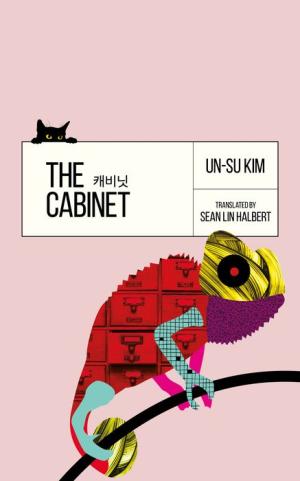Upon finishing Un-su Kim’s The Cabinet, one might well think of the old adage about appearances sometimes being deceiving. This is both a theme that some of the scenarios posited within the novel return to again and again and a statement about the novel itself—a book that pivots from a catalog of strange phenomena into a story of bureaucratic intrigue with some shockingly visceral moments. It isn’t a book that ever feels predictable.
Initially, Kim’s novel (translated into English by Sean Lin Halbert) takes the form of vignettes in which instances of surreal or uncanny events are described in great detail. The subject of one develops the ability to exhale methane gas, to flammable effect; the subject of another begins growing a ginkgo plant from his body, which slowly begins to dominate his life. The Cabinet begins with an account of the story of Ludger Sylbaris, a man who survived a volcanic eruption in the town of Saint-Pierre, Martinique. It sounds too strange to be true—but it turns out that the broad contours of the story of Sylbaris’s survival are indeed accurate (though Kim’s account of it differs from the historical record in some respects).
Leading off with a moment of truth that’s stranger than fiction casts the rest of what follows in a different light, and it’s somewhat reminiscent of Paul Thomas Anderson’s 1999 film Magnolia, which begins with a trio of vignettes that stand apart from the rest of the film. The Cabinet is a story about bizarre happenings, but it’s also told from the perspective of an office worker, Mr. Kong, who regularly interacts with a series of case files on “the wounded symptomers of this city,” which provide the bulk of the book’s first half.
Buy the Book


The Cabinet
While the events depicted veer into the fantastical—note the aforementioned gingko tree, or another vignette in which one man’s artificial fingers begin to merge with the flesh of his body—the tone in which they’re recounted is intentionally dry. There’s certainly plenty of precedent for this; the short fiction of Steven Millhauser or Dolan Morgan, as well as Yan Ge’s novel Strange Beasts of China, all come to mind.
One scene finds Mr. Kong examining a particular case file, focusing on a woman whose tongue is gradually devoured by a lizard living in her mouth. There are echoes here of a real-world instance of parasitism in fish. (Which, I’ll be honest, is something I really wish I didn’t know to be the case. There’s something in the “things I can never unsee” category, I’ll say that.) He finds these records within Cabinet 13, the object that gives the book its title. And while he’s horrified by this particular case file, he also takes note of some key phrases, including “chimera.”
The passage about the woman with a lizard in her mouth also echoes one of the stranger motifs running throughout the book: that of people whose delusions end up becoming de facto reality. Kim takes the narrative to some unexpected places, exploring the blending of human and nonhuman bodies in some scenes and using others to explore the ways a person’s perception of reality can lead to a kind of transformation of that reality. Is this the beginning of the next evolution of humanity, or are these more isolated cases?
The way that the plot of The Cabinet slowly coheres is one of its most impressive qualities. The encounters and observations that seem arbitrary at first eventually converge into a reality-bending narrative with detours into paranoia, satire, and body horror. Even when the novel is in more mundane territory, it can still veer on the absurd—Mr. Kong and his colleague Ms. Son go out for a meal that involves consuming absurd amounts of both sushi and sake, for one thing. At times The Cabinet feels like a workplace satire; in others, it’s in some post-Ballard liminal space where everything is in a state of perpetual flux.
Unfortunately, the second half of the novel also incorporates a more familiar plot—one in which Mr. Kwon is approached by sinister forces asking him to take part in a bit of espionage and betray his supervisor, Professor Kwon. It’s unclear how much of the paranoid-thriller element of this subplot is meant to be taken at face value, right up until a shockingly violent scene that feels out of step with what’s come before.
It’s the small details that make The Cabinet compelling, though, and this novel has them in abundance. The lives of the symptomers that Mr. Kong monitors are compelling on their own. Like them, this book eludes easy description, and at its best it charts out its own distinctive corner of fiction to call home.
The Cabinet is published by Angry Robot Books.
 Tobias Carroll is the managing editor of Vol.1 Brooklyn. He is the author of the short story collection Transitory (Civil Coping Mechanisms) and the novel Reel (Rare Bird Books).
Tobias Carroll is the managing editor of Vol.1 Brooklyn. He is the author of the short story collection Transitory (Civil Coping Mechanisms) and the novel Reel (Rare Bird Books).










